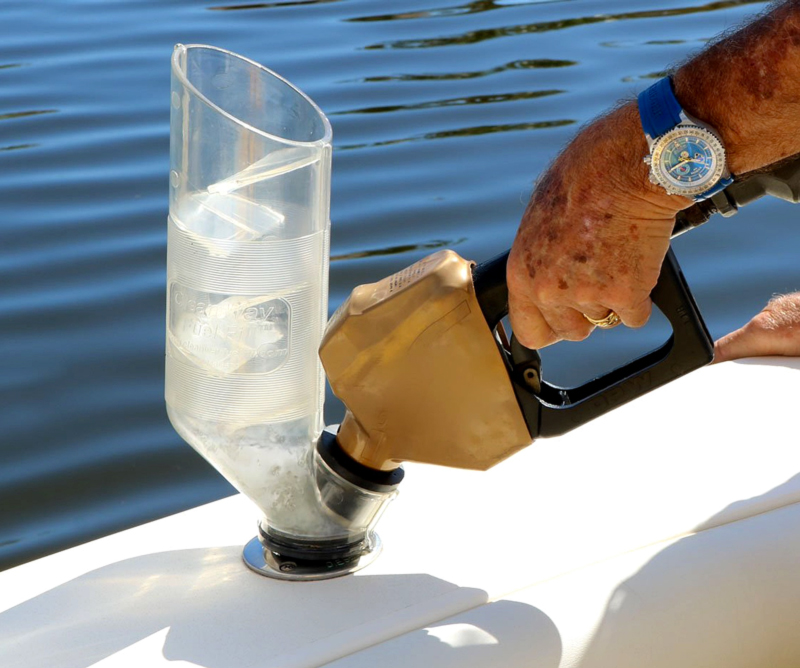It’s easier than you think to accidentally turn what should be a routine chore at the fuel dock into a first-class mess. Part of being a sensible, responsible angler is ensuring that your boat’s fuel tanks are filled correctly and no fuel is spilled into the water, which can have significant consequences for aquatic life. Here are 10 simple ways to avoid this issue.

- Make sure that you’re putting fuel into the correct tank. GEICO | BoatU.S. receives claims each year from someone pumping fuel into a rod holder or water tank.
- Fill tanks only to about 95-percent capacity to allow for expansion and sloshing as the boat moves.
- Do not top off the tank, or the boat’s movement may cause fuel to leak from the tank vent.
- Use absorbent sheets or pads around the fuel pump nozzle while transferring it from the dock to the boat and while filling to prevent splashes. And always keep oil-absorbent pads within quick reach should something go wrong. An internet search will reveal various products to help prevent spills.
- Listen carefully as the tank gets close to being filled. It’s often possible to hear when the fuel is getting to the top of the tank and when you hear gurgling, you know it’s time to stop the pump.
- Hold (or have someone else hold) a highly absorbent rag or fuel absorbent pad at the fuel tank’s air vent to absorb any spillage from the vent. Or, consider purchasing a fuel-vent collection device that sticks on the outside of the boat with suction cups to collect any fuel that happens to find its way out of the vent.
- Consider installing a whistle in the fuel-vent line, designed to make noise as long as fuel is flowing. As soon as the tank is full the whistle stops, and you know it’s time to stop the pump.
- Don’t let higher pump speeds catch you unaware. Some fuel dock pumps fill at a much quicker rate than those at the local gas station to allow boats and their large fuel tanks to fill faster. Also, even if a fuel-fill nozzle has a lock-off device, don’t use it. By the time the nozzle catch has tripped and stopped the flow of fuel you may have already sent a fair amount of fuel onto the deck and into the water. This malady is most often caused by "burping," which is the result of air trapped in the tank or the boat's fill hose. It escapes through the fuel fill, bringing fuel with it. You can also use a product like the Clean Way Fuel Fill. In the event of fuel burping back through the filler, excess fuel is directed upward into the device, then downward sloping baffles send overflowing fuel back into the tank.
- Regularly check your fuel system for leaks. Not only is this a fire and explosion hazard, but if fuel leaks into the bilge, it may be pumped over the side by the bilge pump.
- Replace the gas cap after fueling, and maintain the gasketing around the cap.

Fuel in the Bilge
Not all fuel pollution occurs while filling the boat. Bilge water often contains oil, grease, and fuel, especially on inboard and stern drive boats. To prevent this oily water from being pumped overboard by the bilge pump, consider placing oil-absorbent sheets in the bilge. A couple of oil absorbent bilge socks or sausages in the lowest part of the bilge close to the bilge pump pickup (but not interfering with the pickup or switch) will go a long way to preventing dirty bilge water from polluting waterways.
BoatU.S. recommends, at least once a year, checking all fuel hoses for cracks and loose connections that may cause leaks, replacing any that may be suspect. ABYC standards stipulate that all fuel fill hoses should be double-clamped, so ensure that all hose clamps are in place and tight.
What To Do If Fuel Spills
By law, any oil or fuel spill that leaves a sheen on the water must be reported to the U.S. Coast Guard National Response Center by calling (800) 424-8802. If it happens, do not use detergents of any kind to disperse spilled fuel, which does more harm than good. It breaks down the fuel floating on the water into smaller particles, making it much harder to clean up and more toxic to marine life. According to the Environmental Protection Agency, one pint of fuel spilled into the water creates a toxic oil slick that can cover one acre, larger than a football field.
-By Mark Corke
The BoatU.S. Foundation for Safety & Clean Water is a 501(c)(3) nonprofit organization dedicated to keeping boating safe and clean. It is independently funded by donations from BoatU.S. members and grants. Visit BoatUS.org to learn more. This article was reprinted with permission from BoatU.S. Magazine, flagship publication of the membership organization Boat Owners Association of The United States (BoatU.S.). For more expert articles and videos to make your boating, sailing, or fishing better, visit BoatUS.